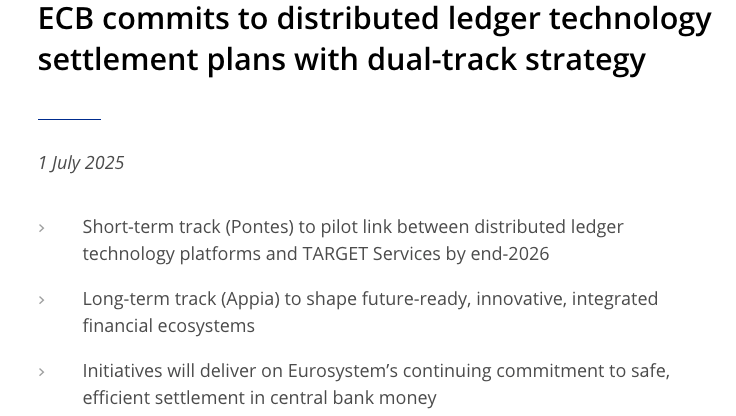The ECB plans to leverage regulated euro stablecoins and private sector innovation, alongside the digital euro, to counter the growing dominance of US dollar stablecoins and reinforce European monetary sovereignty.
-
Euro stablecoins regulated under MiCA could become the EU’s primary response to US dollar stablecoins.
-
Distributed ledger technology (DLT) projects like Pontes and Appia aim to improve Europe’s payment infrastructure.
-
ECB’s decision on advancing the digital euro is expected by the end of 2025, signaling a multi-faceted strategy.
ECB adviser emphasizes euro stablecoins and innovation to challenge US dollar stablecoins. Discover how Europe plans to safeguard monetary sovereignty.
How Are Euro-Based Stablecoins Positioned to Challenge US Dollar Dominance?
The European Central Bank (ECB) adviser Jürgen Schaaf advocates for stronger support of regulated euro-denominated stablecoins as a strategic lever against the rise of US dollar stablecoins. He argues that euro stablecoins, if designed with high standards and effective risk controls, could meet legitimate market needs and bolster the euro’s international role. This approach highlights a shift from relying solely on the digital euro to embracing private innovation within the stablecoin ecosystem.
What Role Does Distributed Ledger Technology Play in Europe’s Payment Strategy?
Schaaf emphasizes that distributed ledger technology (DLT) is a vital component of Europe’s broader digital payments framework. The ECB recently approved two pilot projects, Pontes and Appia, to enhance wholesale and cross-border payments using DLT. These initiatives aim to improve efficiency and security, complementing the digital euro and regulated stablecoins in safeguarding European monetary sovereignty.

When Will the ECB Decide on the Digital Euro’s Future?
The ECB has advanced the digital euro project to its preparation phase as of November 2023, with a final decision on its launch expected by the end of 2025. While the digital euro remains a key pillar, Schaaf’s remarks indicate that Europe is adopting a multi-pronged approach, combining public CBDCs, regulated stablecoins, and private innovation to effectively counter US stablecoin dominance and maintain monetary sovereignty.

What Are the Regulatory Challenges Facing Euro Stablecoins?
Strong global coordination on stablecoin regulation is critical, as highlighted by Schaaf. The disparity between the US GENIUS Act and the EU’s Markets in Crypto-Assets (MiCA) regulation creates challenges for cross-border stablecoin adoption. MiCA aims to provide a robust framework for euro stablecoins, but adoption remains slow. ECB officials, including former Bank of Italy governor Fabio Panetta, stress that the digital euro could accelerate stablecoin acceptance in Europe.
| Stablecoin Type | Adoption Rate | Regulatory Framework |
|---|---|---|
| Euro-Pegged Stablecoins | Limited | MiCA Regulation |
| US Dollar Stablecoins | High | GENIUS Act (US) |
Frequently Asked Questions
What is the ECB’s strategy to counter US dollar stablecoins?
The ECB plans to support regulated euro stablecoins, advance the digital euro, and foster private innovation using distributed ledger technology to maintain European monetary sovereignty.
How does the digital euro fit into Europe’s payment ecosystem?
The digital euro is a public CBDC designed to complement private stablecoins and DLT applications, providing a secure and sovereign digital payment option for European citizens.
How to Understand the ECB’s Multi-Faceted Approach to Stablecoins?
- Support regulated euro stablecoins: Encourage adoption through MiCA-compliant frameworks.
- Develop the digital euro: Progress the CBDC project to enhance monetary sovereignty.
- Leverage DLT innovation: Implement pilot projects like Pontes and Appia to improve payment infrastructure.
- Coordinate regulation globally: Align policies to reduce disparities and foster stablecoin growth.
Key Takeaways
- Euro stablecoins are central: Regulated euro stablecoins could counterbalance US dollar stablecoins under MiCA.
- Digital euro complements innovation: The CBDC is part of a broader strategy including private sector advancements.
- DLT projects enhance payments: ECB-approved pilots aim to strengthen wholesale and cross-border payment infrastructure.
Conclusion
The ECB’s adviser Jürgen Schaaf outlines a comprehensive strategy combining regulated euro stablecoins, the digital euro, and distributed ledger technology to challenge US dollar stablecoin dominance. This multi-pronged approach aims to reinforce European monetary sovereignty while fostering innovation within a robust regulatory framework. The upcoming ECB decision on the digital euro will be pivotal in shaping Europe’s digital financial future.
